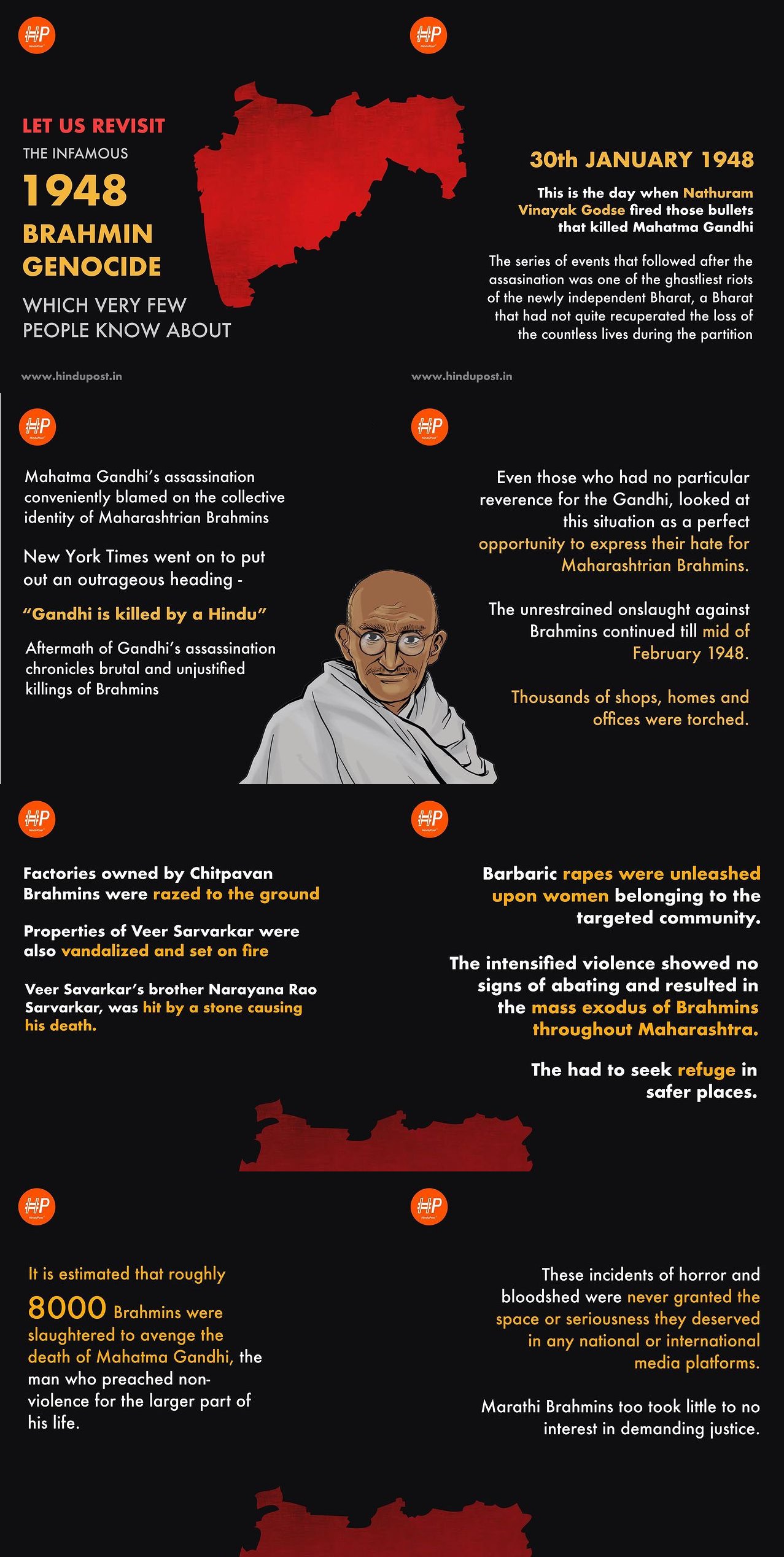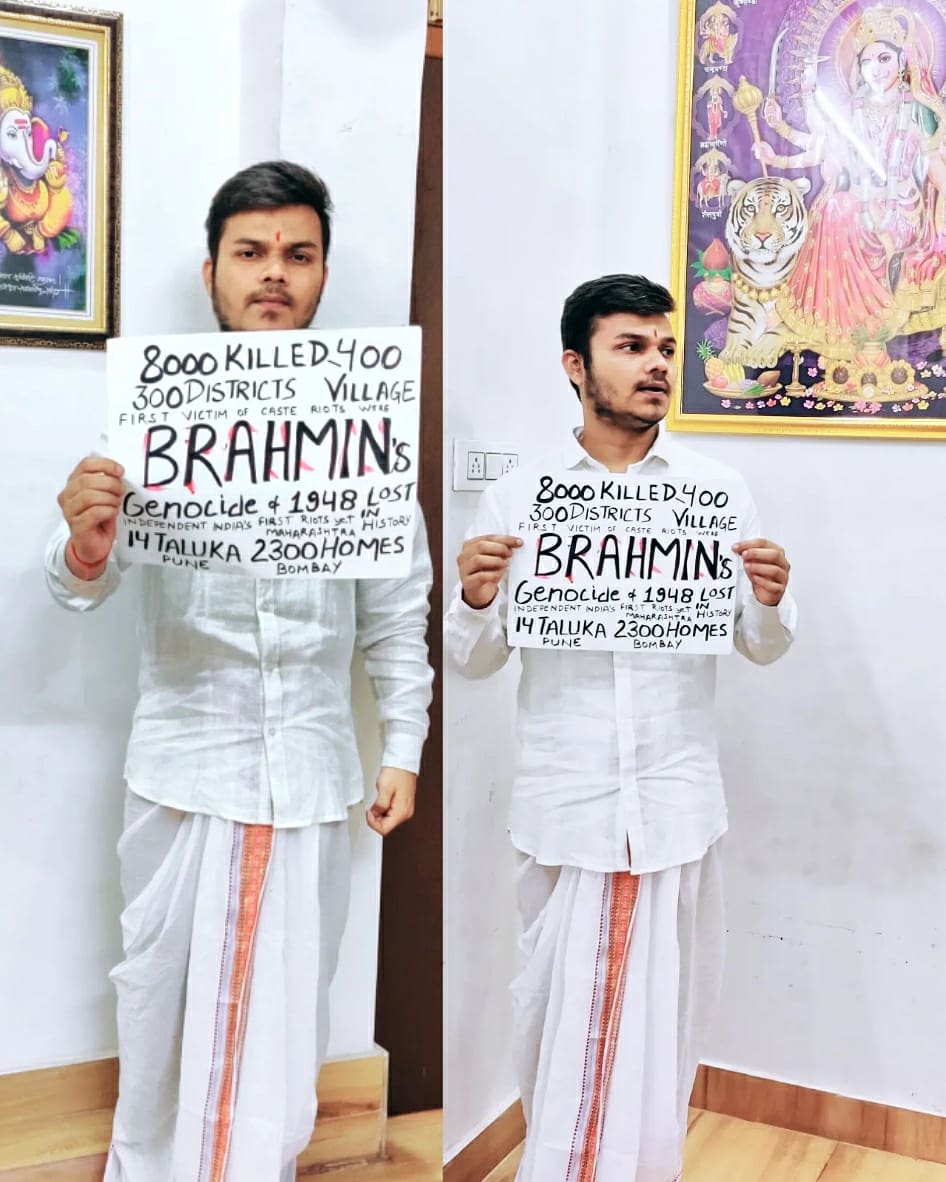A
Aditi Joshi
Guest
The echoes of violence that erupted after the assassination of Mahatma Gandhi by Nathuram Godse in 1948 have reverberated through history. However, one dark chapter remains largely veiled – the widespread massacre of Brahmins in Maharashtra that followed the tragic event. The deliberate cover-up have perpetuated an overlooked atrocity, marking one of the most significant cover-ups in modern history.
On the death anniversary, it is imperative that we shed light on the crimes against the Brahmin community in Maharashtra.
Nathuram Godse, belonging to an orthodox Chittapavan Brahmin family in Pune, assassinated Gandhi on January 30, 1948. This event triggered a violent backlash against Brahmins, driven by existing resentment cultivated during their historical dominance under the Peshwa family. The flames of violence ignited in Pune, swiftly spreading across Maharashtra, leaving in its wake destruction and loss.

PC HinduPost
The New York Times reported communal riots in Bombay, with fifteen people killed and over fifty injured on the day after Gandhi’s assassination. The violence escalated in southern and western Maharashtra, with Nagpur emerging as a hotbed of unrest.
Advocate P.L. Inamdar noted that Brahmins faced persecution simply because Nathuram Godse belonged to their community. The manhunt spared no one, targeting Maharashtrian Brahmins indiscriminately. Dwarka Prasad Mishra, a senior Congress leader, admitted that Congressmen, including office bearers, played a role in the violence in Nagpur and Berar.
Patterson estimated the total damage caused by violent activities to be around Rs. 6 to 10 crores, detailing property damages, burning of homes, and destruction of businesses owned by Brahmins in various districts. The violence, initially directed at those surnamed ‘Godse,’ soon spread across all subcastes, affecting Deshastha and Karhade Brahmin communities as well.

PC Vinayak Dev Trivedi
The anti-Brahmin violence had multiple narratives at play. Initially driven by the Gandhian Ahimsa-vaadis seeking vengeance for Gandhi’s murder, it was later fueled by non-Brahmin leaders with personal grudges against the influential Brahmins. Historical resentment against the Brahmins’ hegemonic control and discriminatory practices also played a role, exacerbated by events like the Bheema-Koregaon battle where lower castes were pitted against the Brahmin-led Maratha Empire.
The aftermath of the violence continues to cast a shadow on Maharashtra’s political landscape. The narrative of a ‘progressive Maharashtra’ led by the ideals of ‘Shahu-Phule-Ambedkar’ marginalizes Brahmin leaders.

PC Vinayak Dev Trivedi
The silence of the victims and their subsequent migration to cities during the 1960s highlight the lasting impact of the atrocities. Today, the Maharashtrian Brahmins, constituting a minority. They lack political influence in a state dominated by the Marathas and the Kunbis.
The post Gandhi, Godse and The 1948 Brahmin Massacre in Maharashtra appeared first on The Jaipur Dialogues.
Continue reading...
On the death anniversary, it is imperative that we shed light on the crimes against the Brahmin community in Maharashtra.
The Spark of Violence:
Nathuram Godse, belonging to an orthodox Chittapavan Brahmin family in Pune, assassinated Gandhi on January 30, 1948. This event triggered a violent backlash against Brahmins, driven by existing resentment cultivated during their historical dominance under the Peshwa family. The flames of violence ignited in Pune, swiftly spreading across Maharashtra, leaving in its wake destruction and loss.

PC HinduPost
The New York Times reported communal riots in Bombay, with fifteen people killed and over fifty injured on the day after Gandhi’s assassination. The violence escalated in southern and western Maharashtra, with Nagpur emerging as a hotbed of unrest.
Persecution of Brahmins:
Advocate P.L. Inamdar noted that Brahmins faced persecution simply because Nathuram Godse belonged to their community. The manhunt spared no one, targeting Maharashtrian Brahmins indiscriminately. Dwarka Prasad Mishra, a senior Congress leader, admitted that Congressmen, including office bearers, played a role in the violence in Nagpur and Berar.
Media blackout and state pressure contributed to the scarcity of information about the events. British journalist Maureen Patterson’s research on the aftermath of Gandhi’s assassination finally brought attention to the violence against Brahmins in 1948. There were documented instances of targeting, riots and disturbances. These led to the expulsion of Brahmins from rural Maharashtra.
The Toll of Violence:
Patterson estimated the total damage caused by violent activities to be around Rs. 6 to 10 crores, detailing property damages, burning of homes, and destruction of businesses owned by Brahmins in various districts. The violence, initially directed at those surnamed ‘Godse,’ soon spread across all subcastes, affecting Deshastha and Karhade Brahmin communities as well.

PC Vinayak Dev Trivedi
Roots of Anti-Brahmin Resentment:
The anti-Brahmin violence had multiple narratives at play. Initially driven by the Gandhian Ahimsa-vaadis seeking vengeance for Gandhi’s murder, it was later fueled by non-Brahmin leaders with personal grudges against the influential Brahmins. Historical resentment against the Brahmins’ hegemonic control and discriminatory practices also played a role, exacerbated by events like the Bheema-Koregaon battle where lower castes were pitted against the Brahmin-led Maratha Empire.
Modern Implications:
The aftermath of the violence continues to cast a shadow on Maharashtra’s political landscape. The narrative of a ‘progressive Maharashtra’ led by the ideals of ‘Shahu-Phule-Ambedkar’ marginalizes Brahmin leaders.

PC Vinayak Dev Trivedi
The silence of the victims and their subsequent migration to cities during the 1960s highlight the lasting impact of the atrocities. Today, the Maharashtrian Brahmins, constituting a minority. They lack political influence in a state dominated by the Marathas and the Kunbis.
The post Gandhi, Godse and The 1948 Brahmin Massacre in Maharashtra appeared first on The Jaipur Dialogues.
Continue reading...
